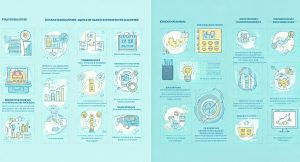How to Implement Behavioral Science Strategies in Business
Key Highlights
- Understanding Human Behavior: Businesses can use behavioral science to learn how customers and employees act and predict their actions.
- Insight from Data: Mixing behavior insights with regular data can help in making better choices in many areas.
- Increasing Engagement and Productivity: Behavioral science can motivate employees, improve communication, and help create a positive work environment.
- Focus on Customers: Learning about biases and how people make decisions can strengthen marketing and enhance customer experiences.
- Creating Wise Choices: By applying behavioral science methods, businesses can make smart decisions and lessen the chances of bias.
Boost your productivity by understanding your behavioural profile with our DISC assessment tool.
Click here to get started.
Introduction
In today’s tough market, businesses need to be different. This is where behavioral science is important. By knowing about human behavior and how the mind functions, decision makers can gain helpful insights. They can use these insights to make their marketing better, improve their operations, and help their businesses grow.
Understanding Behavioral Science in Business

Behavioral psychology helps us understand what affects our choices and actions. It combines ideas from social psychology, cognitive psychology, and behavioral economics. When businesses study these fields, they can find out what drives their customers and employees.
This approach is different from regular market research methods. Normally, those methods depend on what people say. However, behavioral science uses tests and studies. This reveals hidden biases and the factors that affect our actions. With this understanding, businesses can create better and more targeted plans.
The Role of Cognitive Biases and Heuristics in Decision-Making
Cognitive biases are errors in our thinking. They happen when our brains try to figure things out quickly. Heuristics are simple rules we use to make fast decisions. While these quick thoughts can help us, they can also lead us to make choices that are not very good.
Confirmation bias happens when we pay more attention to information that matches what we already believe. The availability heuristic tricks us into thinking some events occur more often just because they are easy to recall. If businesses can recognize these biases, they can find ways to lessen their impact on choices.
When we learn about how these biases affect human behavior, businesses can help students make better choices. They can change how they give information, offer more context, or use nudges to lead people toward better results.
Identifying Common Decision Making Traps
Businesses, like people, can fall into bad habits when making choices. They often rely on gut feelings or past experiences too much. A common mistake is called anchoring bias. This means the first piece of information can unfairly affect later decisions. For example, if someone starts a negotiation with a low offer, it can be hard to get a better deal afterward.
Another common mistake is the sunk cost fallacy. This fallacy occurs when we keep using our time, money, or effort on something that isn’t working. We do this just because we have already invested so much in it. If businesses understand this fallacy, they can know when to stop and look for better opportunities.
By knowing how cognitive processes affect behaviour, companies can give their teams the right tools. This helps stay away from common mistakes. As a result, the decision-making in the company gets better and is more informed.
Preparing to Implement Behavioral Science Strategies
Transitioning from theory to action needs good planning and a clear direction. Start by creating a team culture that encourages trying new ideas. It is also important to learn from both successes and failures. Remember, using behavioral science is not an easy solution. It requires ongoing testing, learning, and improving.
- First, find important areas in your business where behavioral science can really help.
- This can be making marketing better, improving how people communicate in the company, or getting better at hiring.
Essential Resources for a Behavioral Science Approach
The good news is that you don’t need a PhD in behavioral science to use behavioral insights in your business. There are many resources available. These resources can help businesses, whether big or small, learn the basics.
You can begin by looking at books, articles, and online courses. They will help you learn main ideas and see how behavioral science works in real life. You should also talk to experts and go to conferences. This will let you learn about new research and discover the best ways to practice in this field.
Having a basic understanding of key ideas can help you see what you learned before. This can change how you look at problems in your business. Always keep learning. Stay updated on changes in behavioral science to make the most of its benefits.
Building a Foundation: Key Principles and Theories
A simple understanding of the main ideas in behavioral economics and psychology is important for using them correctly. A clear example is loss aversion. This means people work harder to keep what they have than to gain something of equal value.
Framing is an important concept. It refers to how we share information that can affect our choices. When companies change the way they present options, they can help people make better decisions. For instance, showing the advantages of a product instead of only its features can greatly affect how people act.
These are some ideas in behavioral science. By looking at these important principles, businesses can learn how to create good plans to change behavior. It’s not about tricking people. It’s about understanding human behavior. This can guide choices that are good for both the people and the business goals.
Step-by-Step Guide to Applying Behavioral Science

Using behavioral science in your business means having a clear plan. This helps you use these ideas in your company’s operations. By taking simple steps, you can use these principles to make better choices and achieve good results.
Here are some easy steps to use behavioral science strategies in your organization. These steps will help you build a strong base for long-term success.
Step 1: Assessing Decision-Making Frameworks Within Your Business
The first step is to look closely at how your organization makes decisions. You need to find areas where hidden biases or common thinking might stop you from getting better results. For example, check your hiring practices, marketing plans, or how you develop products.
Next, look for the main decision points in each process. Are there moments when people or teams trust their feelings or instincts? If you spot these times, you can use behavioral science tools. This can help you make choices based on facts and data, rather than just gut feelings.
Applying behavioral science does not mean you should ignore your intuition. It means you should understand when intuition is not enough. By knowing this, you can make a system that combines human judgment and reliable data. You should also pay attention to cognitive biases. This way, your organization can build a culture where people feel empowered to make better and informed decisions.
Step 2: Integrating Behavioral Insights into Business Strategy
Once you find important areas to improve, the next step is to add behavioural insights to your business strategy. This is more than just using different methods. It means making these ideas a part of your company’s culture.
One good way to improve is by adding behaviour change interventions, or “nudges,” to your current methods. Nudges are small changes in the environment or the way choices are shown. They help to gently guide people towards better behaviour. For example, you can set default options to help employees save money for retirement. You can also show social proof in advertisements to encourage people to use a product more.
By using these tips correctly, businesses can change what customers do. They can also make employees feel better and get better results. Start with small steps. Try new ideas and see how well they do. Make changes if needed.
Cultivating a Decision-Making Culture
To use behavioral science effectively, you need to create a culture that respects clear thinking and ideas based on data. You should also be willing to challenge old beliefs. This means setting up a workplace where every employee feels safe to ask questions and share their new ideas.
Regular practice and workshops can help your team see their biases. This can lead to better decisions. You should encourage open discussions about cognitive biases and how they affect business results. Doing this will build a culture of shared learning and ongoing growth.
Encouraging Rational Thinking and Overcoming Biases
A big part of making good choices is being clear in your thoughts. It’s also key to understand how biases can affect our decisions. Companies should look for ways to reduce these biases. By doing this, they can make choices based on facts and be more fair.
One good way to do this is by using “debiasing” strategies. These strategies create clear rules for making choices. They also encourage different opinions and help improve critical thinking skills. When companies teach their workers about cognitive biases, they create a culture of awareness. This helps teams to think carefully and question their assumptions.
It is important to use data when making decisions. Don’t just trust your instincts or past actions. Instead, focus on data analysis and strong evidence to help you make clever choices. When facts back your decisions, companies can lower the influence of emotions. This leads to better and more informed choices.
Balancing Intuition with Data-Driven Decisions
When you want to work in a better and more organized way, it is important to balance your gut feelings and decisions based on data. Your instincts come from years of experience and noticing patterns. They can be very helpful, especially in tough and fast-moving situations.
The important thing to know is that intuition is stronger when it works together with data. This combination helps businesses use both human insight and detailed analysis. For example, artificial intelligence can look at a lot of data to find patterns. Still, human intuition matters too. It helps to really understand those patterns and make wise choices in strategy.
To build a workplace that values data and experience, businesses can encourage smart and balanced decisions. This means that employees should feel confident in their instincts. However, it is also important for them to look for data and facts that back up their ideas.
Conclusion
In business strategies, using behavioral science can change decision-making. When companies know about cognitive biases and fast judgments, they can make better plans. This improves smart thinking. Learning about behavioral insights is important for building better strategies. This method is crucial for meeting today’s market challenges. To learn more about this useful approach, sign up for a free trial, demo, or consultation with our experts today.
Frequently Asked Questions
How Can Behavioral Science Improve Business Strategy?
The good news is that behavioral science helps decision makers in the United States. It offers important insights into how people act. This information can make marketing better. It can also improve operations and explain why customers behave in certain ways.
How to Start Implementing Behavioral Science in Small Businesses?
Small businesses can start using behavioral science by making simple changes. These changes might include altering marketing messages or using social proof. You can find resources online, go to workshops, or get a certificate to learn the basics.
Can Behavioral Science Strategies Coexist with Data Analytics?
Behavioral science strategies are more effective when combined with data analytics. Data reveals what people do. Behavioral science explains why they do it. By merging these two approaches, we achieve better results.

Haya is a third-year graduate student in the Faculty of Engineering with a passion for English literature and a flair for writing for small businesses. Currently interning at Grow Partnership, she is refining her writing skills and gaining valuable corporate experience. In her free time, Haya enjoys reading, swimming, and drawing.


